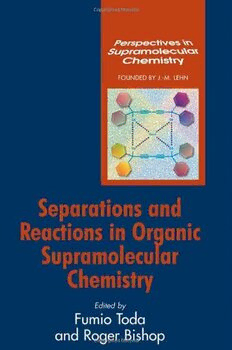
Separations and Reactions in Organic Supramolecular Chemistry: Perspectives in Supramolecular Chemistry PDF
Preview Separations and Reactions in Organic Supramolecular Chemistry: Perspectives in Supramolecular Chemistry
SeparationsandReactionsinOrganicSupramolecularChemistry:PerspectivesinSupramolecular Chemistry.Volume8.EditedbyFumioTodaandRogerBishop Copyright2004JohnWiley&Sons,Ltd.ISBN:0-470-85448-0 Separations and Reactions in Organic Supramolecular Chemistry Editorial Board Founding Editor J.-M. Lehn, Colle`ge de France, Chimie des Interactions Mole´culaires, 11 Place Marcelin Berthelot, 75005 Paris, France Editors C.J. Burrows, Office 3152 HEB, Department of Chemistry, University of Utah, 315 S. 1400 East, RM Dock, Salt Lake City, UT 84112, Utah, USA G.R.Desiraju,UniversityofHyderabad,SchoolofChemistry,Hyderabad500046, India A.D. Hamilton, Yale University, Department of Chemistry, New Haven, CT 06520, USA D. Hilvert, Laboratorium fu¨r Organische Chemie, ETH Zentrum, Universita¨ts- strasse 16, 8092 Zu¨rich, Switzerland D.N. Reinhoudt, University of Twente, Faculty of Chemical Technology, P.O. Box 217, NL-7500 AE Enschede, The Netherlands J.-P Sauvage, Universite´ Louis Pasteur, Institut le Bel, 4 Rue Blaise Pascal, F-67070 Strasbourg, France Former Editors J.-P. Behr, Faculte´ de Pharmacie. Universite´ Louis Pasteur, Strasbourg, B.P. 24, F-67401 Illkirch, France T.Kunitake,KyushuUniversity,FacultyofEngineering.Hakozaki,Fukuoka812, Japan Separations and Reactions in Organic Supramolecular Chemistry Perspectives in Supramolecular Chemistry Volume 8 EDITED BY FUMIO TODA OkayamaUniversity of Science,Japan AND ROGER BISHOP University of NewSouth Wales, Sydney,Australia Copyright2004 JohnWiley&SonsLtd,TheAtrium,SouthernGate,Chichester, WestSussexPO198SQ,England Telephone(+44)1243779777 Email(forordersandcustomerserviceenquiries):[email protected] VisitourHomePageonwww.wileyeurope.comorwww.wiley.com AllRightsReserved.Nopartofthispublicationmaybereproduced,storedinaretrievalsystemor transmittedinanyformorbyanymeans,electronic,mechanical,photocopying,recording, scanningorotherwise,exceptunderthetermsoftheCopyright,DesignsandPatentsAct1988or underthetermsofalicenceissuedbytheCopyrightLicensingAgencyLtd,90TottenhamCourt Road,LondonW1T4LP,UK,withoutthepermissioninwritingofthePublisher.Requeststothe PublishershouldbeaddressedtothePermissionsDepartment,JohnWiley&SonsLtd,The Atrium,SouthernGate,Chichester,WestSussexPO198SQ,England,oremailedto [email protected],orfaxedto(+44)1243770620. Thispublicationisdesignedtoprovideaccurateandauthoritativeinformationinregardtothe subjectmattercovered.ItissoldontheunderstandingthatthePublisherisnotengagedin renderingprofessionalservices.Ifprofessionaladviceorotherexpertassistanceisrequired,the servicesofacompetentprofessionalshouldbesought. OtherWileyEditorialOffices JohnWiley&SonsInc.,111RiverStreet,Hoboken,NJ07030,USA Jossey-Bass,989MarketStreet,SanFrancisco,CA94103-1741,USA Wiley-VCHVerlagGmbH,Boschstr.12,D-69469Weinheim,Germany JohnWiley&SonsAustraliaLtd,33ParkRoad,Milton,Queensland4064,Australia JohnWiley&Sons(Asia)PteLtd,2ClementiLoop#02-01,JinXingDistripark,Singapore129809 JohnWiley&SonsCanadaLtd,22WorcesterRoad,Etobicoke,Ontario,CanadaM9W1L1 Wileyalsopublishesitsbooksinavarietyofelectronicformats.Somecontentthatappears inprintmaynotbeavailableinelectronicbooks. LibraryofCongressCataloging-in-PublicationData Separationsandreactionsinorganicsupramolecularchemistry/edited byFumioTodaandRogerBishop. p. cm.–(Perspectives in supramolecular chemistry ; v. 8) Includesbibliographicalreferencesandindexes. ISBN0-470-85448-0(cloth:alk.paper) 1.Supramolecularchemistry.2.Chromatographicanalysis.3. Chemicalreactions.I.Toda,Fumio.II.Bishop,Roger.III.Series. QD878.S472004 547(cid:1).1226–dc22 2003020628 BritishLibraryCataloguinginPublicationData AcataloguerecordforthisbookisavailablefromtheBritishLibrary ISBN0-470-85448-0 Typesetin10/12ptTimesbyLaserwordsPrivateLimited,Chennai,India PrintedandboundinGreatBritainbyAntonyRoweLtd,Chippenham,Wiltshire Thisbookisprintedonacid-freepaperresponsiblymanufacturedfromsustainableforestry inwhichatleasttwotreesareplantedforeachoneusedforpaperproduction. Contents Contributors vii Preface ix 1 Inclusion Complexation as a Tool in Resolution of Racemates and Separation of Isomers 1 Zofia Urbanczyk-Lipkowska and Fumio Toda 2 Enantiomer Ordering and Separation During Molecular Inclusion 33 Roger Bishop 3 Molecular Recognition of Crystalline Dipeptides and Its Application to Separation 61 Katsuyuki Ogura and Motohiro Akazome 4 Separation of Isomers and Enantiomers by Bile Acid Derivatives 87 Mikiji Miyata, Nungruethai Yoswathananont, Kazunori Nakano and Kazuki Sada 5 Physicochemical Studies of Separation of Isomers by Supramolecular Systems 123 Luigi R. Nassimbeni vi Contents 6 Regioselective Synthesis of Fullerene Derivatives and Separation of Isomers of the Higher Fullerenes 137 L. Echegoyen, M. A. Herranz, F. Diederich and C. Thilgen 7 Selective Reactions in Inclusion Crystals 173 Zofia Urbanczyk-Lipkowska and Fumio Toda 8 Supramolecular Control of Reactivity in the Solid State Using Linear Templates 185 Leonard R. MacGillivray 9 Development of a New Biocide as an Inclusion Complex 205 Minoru Yagi, Ayako Sekikawa and Tetsuya Aoki Cumulative Author Index 221 Cumulative Title Index 227 Index 231 Contributors MotohiroAkazome, Department of Materials Technology, Faculty of Engineer- ing, Chiba University, 1-33 Yayoicho, Inageku, Chiba 263–8522, Japan Tetsuya Aoki, Kurita Water Industries Ltd, 4-7 Nishi-Shinjuku, 3-Chome, Shin- juku-ku, Tokyo 160–8383, Japan Roger Bishop, School of Chemical Sciences, University of New South Wales, UNSW Sydney NSW 2052, Australia Franc¸ois Diederich, Laboratorium fu¨r Organische Chemie, ETH-Ho¨nggerberg, Wolfgang-Pauli-Strasse 10, CH-8093 Zu¨rich, Switzerland Luis Echegoyen, Department of Chemistry, Clemson University, 219 Hunter Laboratories, Clemson, SC 29634-0973, USA M A Herranz, Department of Chemistry, Clemson University, 219 Hunter Lab- oratories, Clemson, SC 29634-0973, USA Leonard R MacGillivray, Department of Chemistry, University of Iowa, 323B Chemistry Building, Iowa City, IA 52242-1294, USA Mikiji Miyata, Department of Material and Life Science, Graduate School of Engineering, Osaka University, 2-1 Yamadaoka, Suita, Osaka 565–0871, Japan Kazunori Nakano, Nagoya Municipal Industrial Research Institute, 3-4-41, Rokuban, Atsuta-ku, Nagoya 456-0058, Japan LuigiR Nassimbeni, Department of Chemistry, University of Cape Town, Ron- debosch 7701, South Africa viii Contributors KatsuyukiOgura,DepartmentofMaterialsTechnology,FacultyofEngineering, Chiba University, 1-33 Yayoicho, Inageku, Chiba 263–8522, Japan Kazuki Sada, Department of Chemistry and Biochemistry, Graduate School of Engineering, Kyushu University, 6-10-1 Hakozaki, Higashi-ku, Fukuoka 812– 8581, Japan Ayako Sekikawa, Kurita Water Industries Ltd, 4-7 Nishi-Shinjuku, 3-Chome, Shinjuku-ku, Tokyo 160–8383, Japan CThilgen,Laboratoriumfu¨rOrganischeChemie,ETH-Ho¨nggerberg,Wolfgang- Pauli-Strasse 10, CH-8093 Zu¨rich, Switzerland FumioToda, Departmentof Chemistry, Okayama University of Science,Riday- cho 1-1, Okayama, 700-0005, Japan Zofia Urbanczyk-Lipkowska, Institute of Organic Chemistry, Polish Academy of Sciences, Kasprzaka Str. 44/52, Warsaw, Poland Minoru Yagi, Kurita Water Industries Ltd, 4-7 Nishi-Shinjuku, 3-Chome, Shin- juku-ku, Tokyo 160–8383, Japan NungruethaiYoswathananont,DepartmentofMaterialandLifeScience,Grad- uate School of Engineering, Osaka University, 2-1 Yamadaoka, Suita, Osaka 565–0871, Japan Preface Classicalorganic chemistry largely involves making new molecules by means of structural changes involving strong attractive forces (covalent and ionic bonds), and concomitant studies (structure, reactivity, spectroscopy, applications) of the pure substances thereby produced. Supramolecular chemistry, on the other hand, involves the relationships between molecules that result from weak noncovalent bonding forces. This modern science currently is expanding rapidly in many different exciting directions. A number of excellent books have been written in recent years, covering the general scope of supramolecular chemistry, but less attentionhasbeengiventospecificareasofapplicationthataredevelopingwithin this new field. In this volume we therefore present a selection of topics, written byexpertsinthesefields,dealingwithaspectsofseparationandreactionthatare specific to supramolecular chemistry. Fumio Toda Okayama Roger Bishop Sydney May 2003 SeparationsandReactionsinOrganicSupramolecularChemistry:PerspectivesinSupramolecular Chemistry.Volume8.EditedbyFumioTodaandRogerBishop Copyright2004JohnWiley&Sons,Ltd.ISBN:0-470-85448-0 Chapter 1 Inclusion Complexation as a Tool in Resolution of Racemates and Separation of Isomers ZOFIAURBANCZYK-LIPKOWSKA Institute of Organic Chemistry, Polish Academy ofSciences,01-224 Warsaw, Poland FUMIOTODA Departmentof Chemistry, OkayamaUniversity of Science,Okayama 700-0005, Japan 1 INTRODUCTION Molecular chirality is one of the most intriguing phenomena on Earth. It orig- inated with the evolution of simple achiral molecules into more complex ones, and,asaresult,thestructureandfunctionsofbiologicalsystemsarecontrolledby direct recognition between chiral molecules. The physical and biological proper- ties of various man-made materials depend on their chirality, and careful control ofchiralityatthemolecularandsupramolecularlevelisimportantfortheirperfor- mance. Recently, an increased demand for enantiopure materials has led to the intensive development of strategies to the selective introduction of new chiral centres into molecules. In contemporary synthesis, apart from using chiral start- ing materials (amino acid derivatives, carbohydrates, etc.), the creation of chiral centres via biocatalysis or asymmetrical synthesis is commonly used. Neverthe- less, the resolution of racemates is still necessary in order to prepare optically
